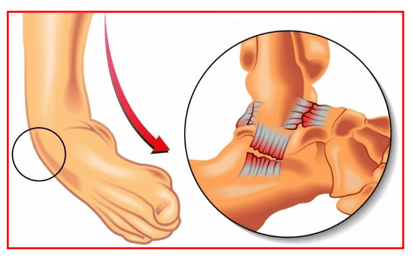Ankle Sprains and Instability
An ankle sprain is an injury to the tough bands of tissue (ligaments) that surround and connect the bones of the leg (tibia) to the foot (talus). This injury typically happens when the patient accidentally twists or turns over their ankle in an awkward way. This can stretch or tear the stabilising ligaments of the ankle, most commonly affecting the outer side ligaments.

An ankle sprain often occurs when the foot suddenly twists or rolls, forcing the ankle joint out of its normal position. During physical activity, the ankle may twist inward as a result of sudden or unexpected movement. This causes one or more ligaments around the ankle to stretch or tear.
Ankle sprains can happen to anyone at any age. Participating in sports, walking on uneven surfaces, or even wearing inappropriate footwear can all cause this type of injury. More common in people with generalised hyperlaxity of their joints.
The patients will give a history of twisting of their ankle. They present with swelling around the ankle joint, skin bruising, difficulty in walking and a limp whilst walking. Patients may also have difficulty in weight bearing and their ankle mobility is painfully limited.
Ankle sprains are diagnosed based on typical medical history, clinical examination of their foot and ankle and investigations like X-rays or MRI of their ankle joint.
Patient’s ankle is swollen, bruised and tender. The outer side or lateral ligaments of the ankle are commonly injured. The ankle movements are painfully limited.
X-rays of the ankle are advised. These may be normal with purely ligamentous injury or it may show presence of fractures e.g. avulsion fracture of the lower fibula.
Ankle MRI is done for suspected fractures, serious injury to the ligaments, or damage to the articular surfaces of the ankle joint.
Ankle sprains can be treated conservatively or surgically.
Conservative treatment consists of:
- Taking regular painkiller medication for few days
- Ice packing the ankle 4 to 5 times a day
- Elevation of the leg whilst sitting or sleeping. This helps reduce ankle pain and swelling.
- Patients may be given a compressive bandage to reduce swelling and provide support to the ankle.
- For severe ankle sprain an ankle walker boot or a below knee plaster cast may be given
- They are allowed to walk full weight-bearing as tolerated with or without walking aids like elbow crutches or a walker.
- Ankle and toe exercises are started as soon as possible. This helps reduce swelling & pain and improves patient’s joint sense (proprioception). Such patients tend to recover faster and avoid repeated sprains
The sprained ligaments heal by 6 weeks, but the ankle can take 3 to 4 months to feel normal. Hence patients are encouraged to keep doing their own exercises for 3 to 4 months and carry on leg elevation when sleeping.
Surgery:
Surgery for sprained ankles is rarely needed.
It is needed if the damage to the ligaments is severe, there is evidence of instability, there is any intra-articular fracture or when the injury doesn’t improve with nonsurgical treatment.
Surgical options include:
Arthroscopy: An ankle arthroscopy is performed through two small incisions at the front of the ankle. The joint surfaces are inspected, inflammatory and scar tissue are removed and any bony spurs (osteophytes) are trimmed and removed. Loose cartilage fragments are also removed. Any lesions of the talar dome are dealt with at the same time.
Repair / Reconstruction:
The type of surgery needed will depend on the severity of the ankle sprain and patient’s activity levels.
An incision is made over the outside of the ankle where the ligaments have been torn away and the ligaments are repaired in an anatomical fashion and reinforced with overlying tissue (modified Brostrum-Gould repair). Surgeons may also use other ligaments or tendons around the foot or ankle to repair the damaged ligaments.
Physiotherapy is very important for recovery after ankle sprain surgery. It helps in regaining ankle mobility and muscular strength. This helps in faster and better functional recovery. Physiotherapy may be needed for 2 to 3 months.
In most cases, an ankle sprain isn’t very serious and will completely heal with proper treatment. The amount of time needed for a full recovery depends on the severity of the sprain. Most ankle sprains take about 6 weeks to fully heal. A more severe sprain may take 2 to 3 months.
Ankle pain settles sooner than the swelling. Patients are forewarned about the time needed for full recovery in order to prevent their anxiety and get them to co-operate with their physiotherapy.
Book An Appointment
Private Clinics : Locations & Directions
London Joints Clinic (Pune)
Address
Office S 5, 2nd Floor, North Block, Sacred World Mall,
Opp Sacred Heart Township, Near Jagtap Chowk,
Wanawadi, Pune 411040
Monday, Wednesday & Friday 7 PM to 9 PM
Sunday 11 AM to 1 PM
Appointments
London Joints Clinic ( PCMC )
Address
C/O Dr Nitin’s Physio Clinic,
Opp. Brahma Hotel,
Near Akurdi Post Office,
Vivek Nagar,
Akurdi,
Pune 411035
Saturdays only 4.30 PM to 7.30 PM
Appointments
Hospitals OPDs : Locations & Directions
Manipal Hospital

Address
Manipal Hospital, Opp D Mart, Baner-Mhalunge Road, Baner, Pune 411 045
Monday to Saturday 11 AM to 4 PM
Appointments
Contact us
Dr Anand Jadhav has a centralised appointment system for all locations across various hospitals and clinics in Pune & PCMC areas
Appointment Bookings & Requests can be made by any method :

